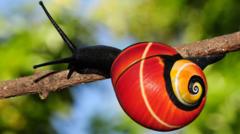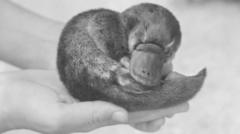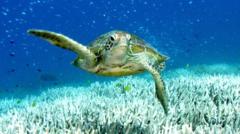Researchers are on a mission to protect Polymita snails, renowned for their vibrant, uniquely patterned shells, from extinction driven by illegal collection and trade. Endemic to Eastern Cuba, these snails face significant threats due to their desirability among collectors and environmental challenges. Working with the University of Nottingham, Cuban conservationists are exploring the species’ genetic makeup to better understand their evolutionary history and enhance conservation efforts. As illegal shell trading persists, this joint initiative aims to preserve the six known species of Polymita, including the critically endangered Polymita sulphurosa, whose striking beauty ironically contributes to its vulnerability.
Saving the World's Most Beautiful Snails: A Race Against Extinction

Saving the World's Most Beautiful Snails: A Race Against Extinction
A collaborative effort between Cuban researchers and UK scientists aims to rescue the endangered Polymita snails from extinction caused by shell trade.
The article text:
Researchers have launched a mission to protect some of the most stunning snails on the planet, renowned not only for their innate beauty but also for the biological secrets they may hold. Endangered Polymita tree snails, native to the forests of Eastern Cuba, are facing drastic declines in population due to the illegal shell trade driven by collectors' lust for their vibrant, intricately patterned shells.
Collaborating with biologists in Cuba, experts from the University of Nottingham in the UK aim to conserve the six known species of Polymita, with the critically endangered Polymita sulphurosa standing out due to its striking lime green shell adorned with blue flame patterns and vibrant orange and yellow bands. However, it's the very splendor of their shells that has led to their precarious situation.
Prof. Angus Davison, an evolutionary geneticist, highlighted the irony of these snails' stunning appearance, which draws collectors and consequently puts them at risk of extinction. "Their beauty attracts people who collect and trade shells. So the very thing that makes them different and interesting to me as a scientist is, unfortunately, what's endangering them as well," he stated.
Research has unveiled that shells are often marketed online, with some sellers based in the UK offering collections of these treasured items for significant sums. "For some of these species, we know they're really quite endangered... It wouldn't take much [if] someone collects them in Cuba and trades them, to cause some species to go extinct," Prof. Davison warned.
Despite the existence of international regulations under the Convention on International Trade in Endangered Species prohibiting the removal of these snails from Cuba without permits, enforcing such laws is a challenge. Meanwhile, other countries can legally sell the snail shells, complicating efforts to protect this species.
The conservation project enlisted the help of Prof. Bernardo Reyes-Tur, a biologist from Universidad de Oriente in Santiago de Cuba. Prof. Reyes-Tur has taken on the arduous task of breeding these snails in captivity despite setbacks such as unstable power supplies and extreme heat. "They have not bred yet, but they're doing well," he shared in a video call.
In the more equipped laboratories at Nottingham, Prof. Davison's team conducts genetic research, freezing small samples of snail tissue to examine their genome, which holds the biological blueprint of each species. The ultimate goal is to elucidate the genetic relationships among the various Polymita species and identify the genetic markers responsible for their extraordinary coloration.
This crucial work is aimed at uncovering biological insights about these snails before they are driven into extinction by relentless collecting. "Eastern Cuba is the only place in the world where these snails are found," Prof. Davison emphasized, highlighting the importance of local expertise and passion for these unique creatures in conservation efforts.
By merging genetic research with on-the-ground conservation efforts, the team hopes to secure a future for these colorful snails, ensuring that their beauty does not lead to their demise.
Researchers have launched a mission to protect some of the most stunning snails on the planet, renowned not only for their innate beauty but also for the biological secrets they may hold. Endangered Polymita tree snails, native to the forests of Eastern Cuba, are facing drastic declines in population due to the illegal shell trade driven by collectors' lust for their vibrant, intricately patterned shells.
Collaborating with biologists in Cuba, experts from the University of Nottingham in the UK aim to conserve the six known species of Polymita, with the critically endangered Polymita sulphurosa standing out due to its striking lime green shell adorned with blue flame patterns and vibrant orange and yellow bands. However, it's the very splendor of their shells that has led to their precarious situation.
Prof. Angus Davison, an evolutionary geneticist, highlighted the irony of these snails' stunning appearance, which draws collectors and consequently puts them at risk of extinction. "Their beauty attracts people who collect and trade shells. So the very thing that makes them different and interesting to me as a scientist is, unfortunately, what's endangering them as well," he stated.
Research has unveiled that shells are often marketed online, with some sellers based in the UK offering collections of these treasured items for significant sums. "For some of these species, we know they're really quite endangered... It wouldn't take much [if] someone collects them in Cuba and trades them, to cause some species to go extinct," Prof. Davison warned.
Despite the existence of international regulations under the Convention on International Trade in Endangered Species prohibiting the removal of these snails from Cuba without permits, enforcing such laws is a challenge. Meanwhile, other countries can legally sell the snail shells, complicating efforts to protect this species.
The conservation project enlisted the help of Prof. Bernardo Reyes-Tur, a biologist from Universidad de Oriente in Santiago de Cuba. Prof. Reyes-Tur has taken on the arduous task of breeding these snails in captivity despite setbacks such as unstable power supplies and extreme heat. "They have not bred yet, but they're doing well," he shared in a video call.
In the more equipped laboratories at Nottingham, Prof. Davison's team conducts genetic research, freezing small samples of snail tissue to examine their genome, which holds the biological blueprint of each species. The ultimate goal is to elucidate the genetic relationships among the various Polymita species and identify the genetic markers responsible for their extraordinary coloration.
This crucial work is aimed at uncovering biological insights about these snails before they are driven into extinction by relentless collecting. "Eastern Cuba is the only place in the world where these snails are found," Prof. Davison emphasized, highlighting the importance of local expertise and passion for these unique creatures in conservation efforts.
By merging genetic research with on-the-ground conservation efforts, the team hopes to secure a future for these colorful snails, ensuring that their beauty does not lead to their demise.



















